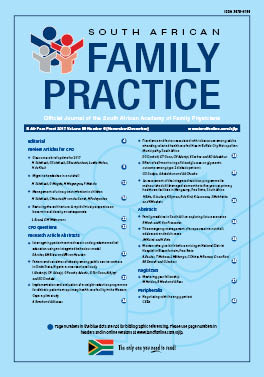Pattern and correlates of obesity among public service workers in Ondo State, Nigeria: a cross-sectional study
Keywords:
diabetes mellitus, hypertension, obesity, overweight, public service workers
Abstract
Background: Obesity is the third leading cause of mortality and has become a global epidemic. There is a continuous increase in its prevalence both in the developed and in developing countries. Obesity is closely associated with chronic health conditions, thus increasing the overall burden of disease and disability at the population level. Several factors have been identified as contributors to the obesity epidemic, and may include the work environment and lifestyle behaviours. This study sought to determine the correlates of obesity among public service workers in Akure, Ondo State, Nigeria. Method: This was a cross-sectional study involving 4 828 public civil service workers across 47 ministries, departments and agencies in Ondo State, Nigeria. Relevant demographic and lifestyle measures were obtained using the World Health Organization (WHO) STEPwise Questionnaire. Height and weight were measured using standardised procedures. Obesity and overweight were defined according to the WHO Criteria as a body mass index (BMI) of ≥ 30 kg/m2 and 25–29.9 kg/m2, respectively. Bivariate and multivariate (logistic regression models) analyses were used to determine the significant predictors of obesity. Results: Of the total participants (n = 4828), there was a male to female ratio of 1:1 (male = 2 299 and female = 2 529). One in every five participants was found to be obese with 55% of the participants having a BMI ≥ 25 kg/m2. In the bivariate analysis, female sex (p < 0.000), age above 41 years (p < 0.000), post-primary education level (p < 0.001), marriage (p < 0.000), no alcohol consumption (p < 0.001), diabetes (p < 0.000) as well as hypertension (p < 0.000) were significantly associated with obesity. In the multivariate analysis, after adjusting for confounders, only female sex (AOR = 5.7, CI = 4.7–6.9), age (AOR = 1.4, CI = 1.1–1.8), level of education (AOR = 0.8, CI = 0.7–0.9), marital status (AOR = 2.1, CI = 1.7–2.), alcohol consumption (AOR = 0.7, CI = 0.5–0.9), diabetes mellitus (AOR = 0.7, CI = 0.5–0.9) and hypertension (AOR = 0.5, CI = 0.4–0.6) were the significant and independent predictors of obesity. Conclusion: This study found a high prevalence of obesity among public service workers in Akure, Nigeria, possibly attributed to ageing, being of female gender, being married, and having other non-communicable diseases. A well-implemented workplace policy focusing on integrated screening for obesity and non-communicable diseases should be prioritised in Nigeria. (Full text of the research articles are available online at www.medpharm.tandfonline.com/ojfp) S Afr Fam Pract 2017; DOI: 10.1080/20786190.2017.1333784
Published
2017-12-05
Section
Research Articles
By submitting manuscripts to SAFP, authors of original articles are assigning copyright to the South African Academy of Family Physicians. Copyright of review articles are assigned to the Publisher, Medpharm Publications (Pty) Ltd, unless otherwise specified. Authors may use their own work after publication without written permission, provided they acknowledge the original source. Individuals and academic institutions may freely copy and distribute articles published in SAFP for educational and research purposes without obtaining permission.

